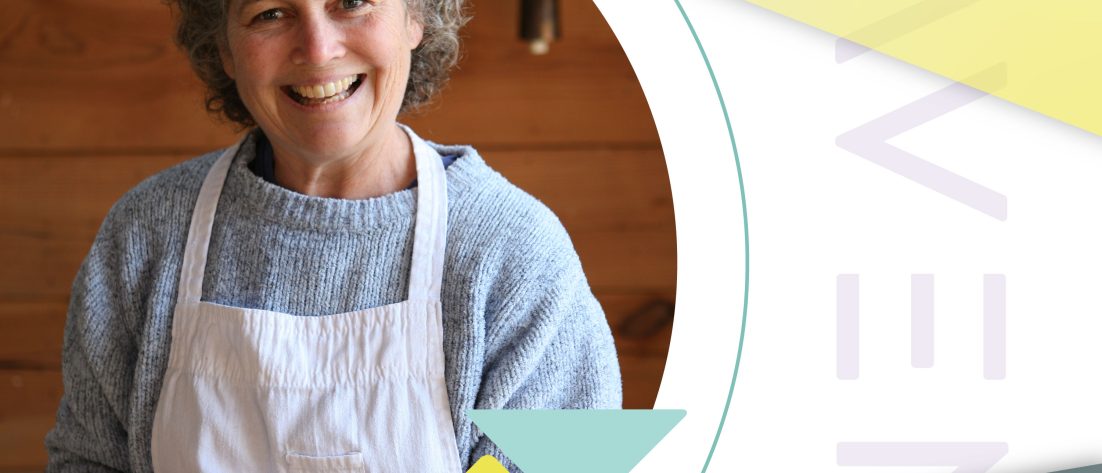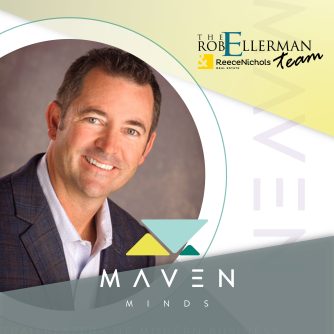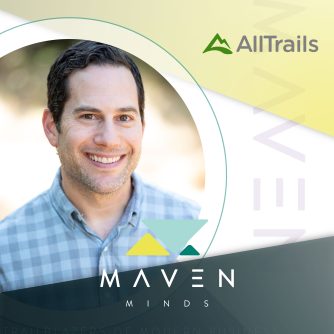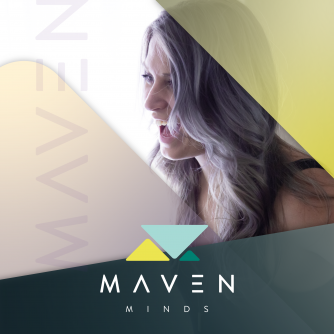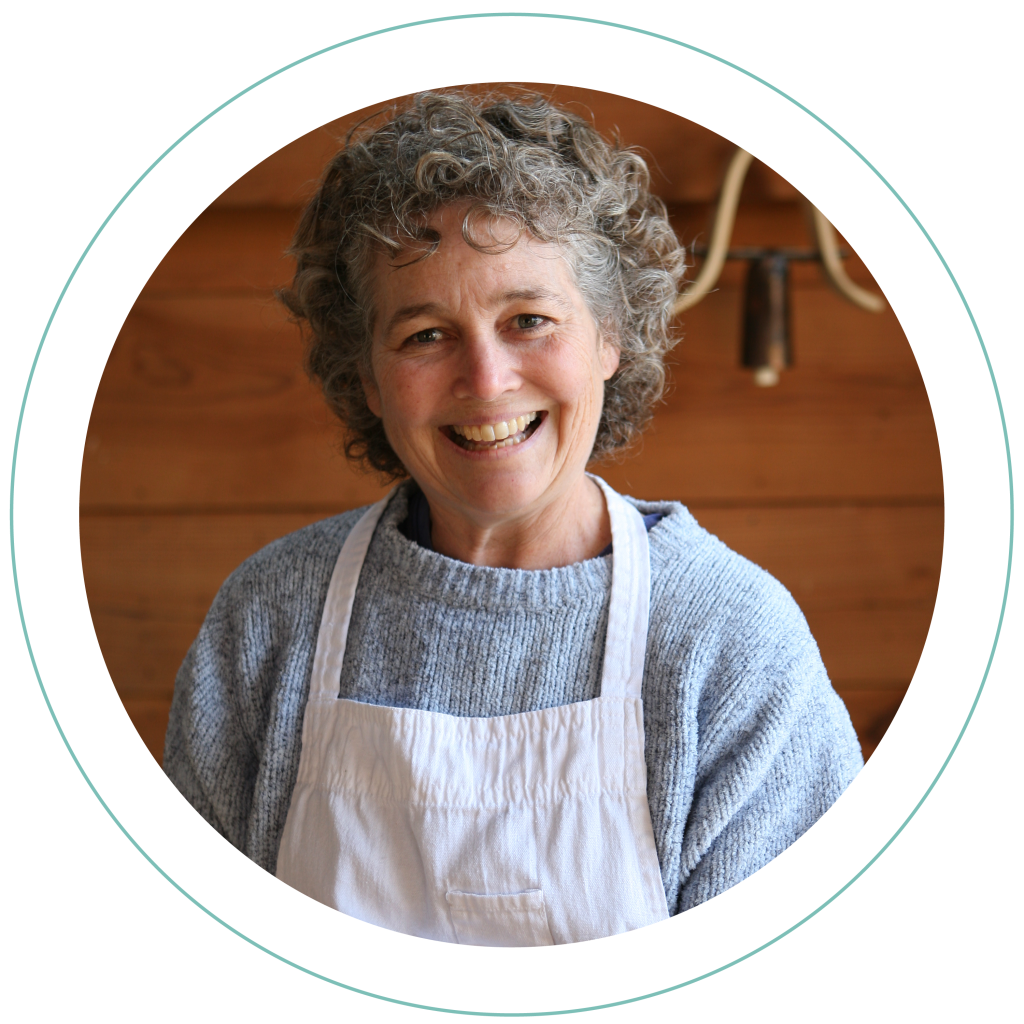
Sarah Hoffman is blazing a new trail in agri-business with her grass-fed, sheep dairy farm. With a strong team of women to support her endeavors, she’s gone from a sheep farmer to cheese maker to restaurateur. Throughout the years, Green Dirt Farm has garnered accolades as one of Food and Wine’s best artisan cheese makers and has won several awards from the American Cheese Society.
While staying true to the handcraft tradition of cheese making, Sarah talks about how they’ve evolved their process to make the most out of the low volume of raw materials that sheep provide.
We are constantly looking for ways that continue to celebrate and use the old methods, but also improve on those and create more efficiencies in the process.
Sarah Hoffman, Green Dirt Farm
In this episode, Sarah discusses:
- The challenges of offering a unique product that’s not well known to consumers
- Creating efficiencies and techniques that celebrate an old-school craft while still accommodating scale
- Utilizing a team to increase opportunities to expand their product
Resources
- Green Dirt Farm
- Green Dirt Farm on Facebook, Instagram (farm), Instagram (creamery)
- Weston cafe: 1099 Welt Street, Weston, Missouri, 64098
- Kansas City Crossroads cafe: coming soon!
- Book a farm tour
Consider and discuss: How can I apply this thinking to my business?
- Are you making your product available in a cost-effective manner?
Are there other ways of getting your product into the hands of people that could be more cost-effective? Can you find distributors to hold your product? Can you get other people to talk about it and get it into the hands of customers? Can you partner with a shop? Can it end up on a menu? What are some other creative ideas you have? - What are you doing to educate your customers?
Do they need it? Do they need to know more about your product or the process, or the benefits? Is it understandable out of the gate? Do they know what your product is or how it works? What questions can you answer for your customers? Are they confused in a spot that you didn’t quite realize? How can you help them along? How can you help them complete that purchase journey? - What are the responsibilities of your team?
Where is the structure? How are you creating operational efficiencies across those? Do you have owners, champions, and people leading? Do you have the support you need to get everyday tasks done?
Key themes
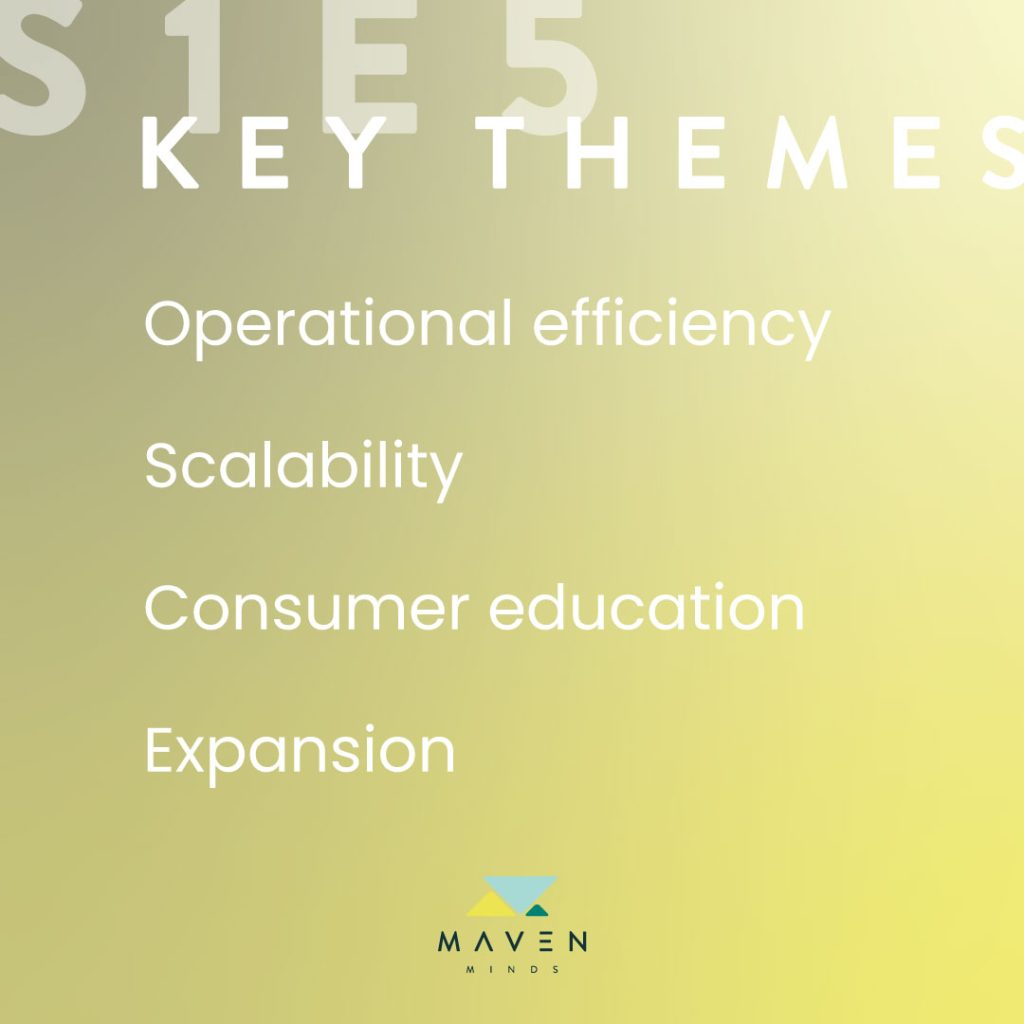
- Operational efficiency
- Scalability
- Consumer education
- Brick and mortar expansion
- Niche product
Transcript
MM EP 5 FINAL
[00:00:00] Laura: Welcome to Maven Minds – the podcast for leaders, entrepreneurs, and innovators to discuss strategies for navigating uncharted territory in modern business. I’m your host, Laura Crossley. Let’s meet the mavens. [00:00:25] Sarah: Creating a job that could be very rewarding and satisfying. And that provided a real living to people was super important to me, as well as getting to that economic sustainability. So we’ve been very sort of, I would say incremental about how we’re growing in order to balance all of those things and support all of those things that were really important values to. [00:00:51] Laura: We’ve got another amazing woman-owned business for you to hear from today. Sarah Hoffman, with Green Dirt Farm out of Western, Missouri. This is an incredible farm and sheep dairy that is raising sheep ag land. They are creating incredible artisan cheeses out of that sheep milk. And, they are opening some shops. [00:01:14] They’ve got a cheese shop, a cafe, and they’ve got new ones on the horizon. And Sarah is going to tell us all about her journey, the challenges, the solutions, the innovations right now on Maven. Well, Sarah, thank you so much for joining us. I have to tell you, when I saw your women-owned business, women-owned farm post on Facebook. [00:01:38] I immediately thought we have to have you. We have to talk with you and learn a little bit about Green Dirt today. So thank you so much for being with us. Tell us a little bit about Green Dirt Farm and this stage of your business. [00:01:52] Sarah: Yeah, well, Green Dirt Farm is a grass-based sheep, dairy and artisan cheese-making business. [00:01:59] That’s how we started. I started the business in 2008. That’s when we got our, I actually started the business in 2002, but we got our commercial cheese making license in 2008. So we’ve been making artisan. For sale since 2008. And I frequently tell people that I started the business in 2002, but I didn’t know how to milk sheep, and I didn’t know how to make cheese. [00:02:25] So, it took me until 2008 to really get all that part of the business squared away so that we could actually be a going concern. I also tell people when I’m talking about the business, that when I say that we are an grass based sheep, dairy and artisan cheese making company, I’m telling you two super unique things about our business. [00:02:48] One is that. We’re a grass based dairy, and that’s a very unconventional way to do dairying. These days is to have our animals out and actually eating grass. We like to say that that’s what they were evolved to eat and they should be eating, but it’s very, very unusual in the dairy world. So being grass based is a very unique thing about us, but also being a sheep. [00:03:11] Dairy is a very unique thing about us. There are fewer than a hundred sheep dairies in all of the us. And probably less than 10 that are making their own artisan cheeses with the milk that they produce. So that also makes us a very unique out of the gate kind of business. And when we first started, I thought that that was a wonderful thing. [00:03:30] I thought that was gonna be a great business opportunity because there are so few and that it would be a great market niche because we actually import greater than 95% of the sheep dairy products that we consume in the us. You know, I thought that that would be a great business opportunity [00:03:50] in addition to the other reasons that we got into sheep dairying, which I’ll, I’ll talk about a little bit more, but it turned out is actually a very challenging business opportunity to do something that [00:04:00] is so unique. And so different. And there are a lot of reasons why that’s really challenging. [00:04:06] We can talk about more about that later. That’s what we do. We have branched out in an effort to get to economic sustainability. We’ve branched out over time to not only add cows milk to our mix of cheeses, our artisan cheeses. So we make blended cow and sheep milk cheeses as well as a hundred percent sheep milk cheeses now, but we’ve also opened our own cafe and retail shop cheese shop that features our cheeses on every menu item. [00:04:36] But that shop also. Is about supporting other local food artisans. so we have, we feature a lot of other local food artisans in our menu items and in the shop you can buy their items and we share part of the shop with a local winery that has a really neat project going on. [00:04:53] Laura: I love that. And is all of that in Weston? [00:04:56] Sarah: Yes. That’s all in Weston. The farm is about four miles outside of Weston. Yeah. And the, cafe and the, the shop itself, the cafe. Is close to downtown Weston. It’s not on Main Street, but it’s close to downtown. [00:05:09] Laura: That’s very cool. [00:05:11] Sarah: Yeah. So that’s really our business in a nutshell. [00:05:14] Laura: I love it. So tell me a bit about, like, I grew up in a farm community. [00:05:20] I live on a farm now and we are like the smallest operation on the planet. Like tiny little hobby, but I cannot believe the amount of work that goes into it. And it’s hard to explain to others the amount of work that has to be accounted for when you’re taking care of land or animals or growing a business on it. [00:05:40] Tell me about your day to day operations and the team and all the hands that you have on deck helping to grow this business. . [00:05:47] Sarah: Yeah, so yeah, I couldn’t do this by myself. There’s no question. I have lots of great help. Many of them are women. my daughter is our farm manager. She manages the whole dairying side of the [00:06:00] business where, you know, the production of the milk, the management and care of the animals. [00:06:04] And then on the, cheese kitchen side, I have Amelia Rogers Jones. She is our director of dairy operations. She manages everything from when the milk gets to us. Including the storage of the milk and handling the milk to the cheese, going out the door for sale. So she manages all of that part of the operation. [00:06:25] We have a head cheese maker in the cheese kitchen, and two cheese making assistance, plus people who help with sort of the day to day cleaning, packaging, order fulfillment, all of that part of the cheese making business. And then we have the cafe side Angela Buckle is our manager on the cafe side. [00:06:46] She manages the women who run the, the cafe. And then we have an events manager, Lena Hummel, another woman who manages our events. We do events on the farm. We do farm table dinners that are all chef driven. You know, the best chefs in Kansas City come up to the farm and create a meal around the products that we produce on our farm. [00:07:06] Plus whatever’s fresh and what’s local at the time. and Lena Humel runs. Those events manages them, organizes them, you know, makes sure that they’re beautifully produced and a great experience for our guests. [00:07:21] Laura: Totally. That is so much fun. Just the, what you were commenting on with the menus and the foods and the cheese-making process… [00:07:28] I’ve had the fortune of trying some of the cheeses in the past. They are phenomenal, and it really is some different flavors, some different combinations that you have. It’s really an incredible product that you’re putting together. [00:07:42] Sarah: Oh, thank you. We’re really proud of our cheeses. It has taken a long time to really perfect them and we’re still, you know, we still are working on them. [00:07:51] It’s really important, an important part of the artisan cheese making process that we are continually observing what is happening with the [00:08:00] milk and adjusting the recipes to changes in the milk. And our goal with artisan cheese making is to create a product that reflects how the milk changes through the seasons, but also to, we wanna make something that’s recognizable and fairly consistent, but each batch of cheese has its own character and its own life and its own, taste and flavors. [00:08:22] So, that’s one of the things that we think makes artisan cheese different than just your mass produced cheese and makes it a great experience. [00:08:30] Laura: When you’re saying that the milk is changing through the seasons, what is it that’s impacting that flavor? [00:08:37] Sarah: Well, in our case, what really impacts flavor a lot is the forages that the animals are eating. [00:08:43] So it’s well known that animals, when they eat grass is particularly a diversity of grasses of rich grasses, they concentrate a lot more flavor compounds in their milk than when they’re fed the kind of monotonous diet that’s [00:09:00] often fed to the typical dairy animal. So I say, I tell people that that’s one of the reasons why we want to be grass based is we’re we’re trying to make a cheese that has a tremendous amount of flavor, good flavor, and captures that essence of the cycles of life on the farm and the changing of the seasons. [00:09:20] You know, gives our customers the experience of the changing seasons and the life cycles on the farm. We don’t want it to be totally consistent in uniform. Of course, we wanna make a, a recognizable product, but not always the same. [00:09:35] Laura: Yeah, that makes a lot of sense. You know, I think that when a lot of people hear the mention of a farm they have in their minds, the, the very antiquated mentality or idea of a tractor and a farmer and a pitch fork, or hay bale, like it’s a very, like, this is what we see on TV about farms, but. [00:09:55] I do think that there’s an understanding in there that might be a [00:10:00] little lost of how much the farm, the farmers, the people that are just there to help, like any aspect that’s it’s very in tune with nature and the animals and the land and what’s happening in those environments. And alongside that, I think. [00:10:18] There’s been a lot of technology and automation and innovation that has come into play, especially in modern farms to help aid. And in those processes of getting at an incredible artisan product. Tell me about some of those technologies and tools that you are all using. [00:10:38] Sarah: Yeah. So while we like to think of ourselves as both science and art, in cheese making, and there are aspects of what we do that are incredibly scientific. [00:10:50] So for example, some of the technologies that we can take advantage of are cultures, cheese, cultures that we buy from culture houses that, help to [00:11:00] flavor our cheeses knowledge about how some of. Cheese cultures help to flavor. Our cheeses also impacts how we make our cheese. We don’t use a lot of automation. [00:11:11] artisan cheese making is about handcrafting, you know, making things and in a kind of old school kind of way, but we have to accommodate some of the issues around scale because we cannot, we cannot become economically sustainable without having the right scale. For our business. So we do have to think about, well, what, how can we make this cheese more efficient? [00:11:38] We do think about that. You know, in the old days we used to hand ladle every cheese into every single cheese form when we were making the cheese. Now we do things a little bit faster, a little bit, you know, in a way that is more efficient. We ladle the cheeses with a. A bucket instead of, and use a curd distributor that helps to distribute the curd [00:12:00] over all of the molds rather than hand labeling each one individually mm-hmm [00:12:05] And we’re about to, get a platform that will allow our VA to be up on a platform so that we can gravity feed from the VA into the molds and distribute the Kurds that way, rather than, using buckets like we have used in the past. So we’re constantly. Looking for ways that continue to celebrate and use old methods, but also improve on those and create more efficiencies in the process that we’re we’re using. [00:12:34] Laura: That makes a whole lot of sense. And it it’s incredible to consider, like you really do want that, small batch handcrafted feel to everything you’re creating, but spot on, like scale would definitely demand that you start to get creative with how you tackle that. Are there other challenges that you faced in trying to grow the business? [00:12:55] Sarah: Well, I would say one of the biggest challenges that we’ve had over the years is just inherent [00:13:00] to sheep dairying in the us, and is probably one of the reasons why we have so few sheep dairies in the us. And that is that sheep naturally produce much smaller volumes of milk than du cows or goats. And while sheep daring has been very traditional and, you know, very beloved in many parts of Europe and Southern Europe and the Mediterranean countries. [00:13:24] It never lent itself very well to commoditization because sheep don’t produce at large scale the way a cow does. So a sheep produces typically about a fifth, the amount of milk that a cow does. And that makes when you spend the same amount of money to get five times less milk. Yeah. It can make it very economically challenging. [00:13:46] And so, one of the things that we have been doing over the years is trying to improve. Production the actual individual animal production in our flock so that our sheep produce a little bit closer to what a goat produces. Typically the [00:14:00] American dairy sheep produces about half what a goat produces and about a fifth of what a cow produces. [00:14:06] Wow. And so over time we hope to get closer to the production capability of goats with our. So we’re, we’ve instituted a very scientific breeding program in with our sheep, where we keep very close watch on the, on the data and the amount of each that each individual sheep produces. And we’re trying to get each of our individual used by breeding up. [00:14:29] We’re getting, a higher production level in our F. [00:14:33] Laura: That is incredible. I had no idea there was that big of a difference between what they each provide, but it makes sense. They’re a much smaller animal in general, right? [00:14:44] Sarah: They’re about the same size as a goat. In fact, some goats are actually smaller than sheep, but they still produce significantly less milk than, than goats to interestingly. [00:14:55] Sheep have a much more concentrated milk. So their milk is about twice as [00:15:00] concentrated. That means more milk solids so you get more cheese per volume of milk, but it still doesn’t compensate for the big difference in production volume. [00:15:10] Laura: Yeah, that makes a whole lot of sense. I’m curious, like knowing that you were talking about like sheep flock in the European countries, and then here is, has it been difficult to bring a sheep milk product to market in the US? Or in the Midwest? [00:15:28] Sarah: In some ways it has, because sheep dairying was not in the sort of American imagination before the 1990s was the first time that dairy sheep were ever brought into the United States. And even though, however, you know, we. A lot of Americans have been eating sheep, dairy products and particularly sheep cheese for, you know, for a long time, maybe didn’t realize it. [00:15:53] And so when we first started, we were often the very first sheep dairy products that our customers had [00:16:00] ever tasted . So we had to get over that hurdle of the lack of familiarity. We had to really educate and do a lot of educating of our customers about what sheep dairy products are and what they taste like and how great they are. [00:16:14] And great for you as well, because that just wasn’t, something that American consumers knew very much about. And if you had immigrated to the United States from one of those countries where cheap dairy products were traditional, you were very sad that you couldn’t find them here. But most Americans, especially in the Midwest were very unfamiliar with them. [00:16:35] And in fact, we even had some of our customers, there was a little bit of a yuck factor, you know, they were kind of like sheep, you can milk sheep. So, we had to overcome that as well. [00:16:46] Laura: That makes a lot of sense. So is most of your business concentrated in the Midwest now since that’s where you are? Or are you nationwide? International? [00:16:54] Sarah: Yeah, we, we are very, we’re not international. We, but we do, ship to the coast and we have distributors on the coast because our cheeses have gotten a lot of notoriety. We’ve won a lot of awards, Food and Wine named us as one of the 50 best artisan cheese makers in the US last year. [00:17:14] And we just came home from the American Cheese Society competition, which is generally considered to be the Oscars of cheese with six awards. Two first place ribbons. It really gives us the joy and the celebration, you know, to keep going and keep doing this. [00:17:32] Absolutely. So, yeah, so we’ve, we’ve had a lot of great reviews of our cheese and we’ve won quite a few awards for our cheeses over the years. [00:17:40] Laura: I love it. So we’ve talked a bit about the challenges and the solutions that you’ve been working through. I’m really curious to know kind of what’s next and on the horizon for the. [00:17:52] Sarah: So we are currently building a new location in downtown Kansas City. This in the east Crossroads. And that will allow us to expand our production. It’ll be the production space will have, it’ll have a cafe like up in Weston, very cheese-centric, menu items and farm centric. [00:18:14] So we’ll be using our, the products of our farm and the products of. local farms in the kitchen. And then, we’ll have a half of the first floor is a production space where we’ll be making our fresh cheese and our hard cheeses, and you’ll be able to look in and watch while the production is going on. [00:18:33] And then upstairs we’re gonna have an event space, so it’ll be, it’s really fun. A really, really fun process. [00:18:41] Laura: You, when, when is that going to be available? Like, I need to go sit in it now. [00:18:48] Sarah: Well, like all of these kinds of projects, we were supposed to be open last January, and then we were supposed to be open in May and then, then we were hoping for Fall. [00:18:56] And now it’s really looking like it’s gonna be early 2023, but we do get closer and closer to a firm opening. I love it with every passing minute, but I don’t think it’s gonna be until 2023 now. [00:19:12] Laura: Tell me a bit about that vision and how long you’ve been working toward these brick and mortar locations, because that is a jump for a lot of businesses that is like on the goals. [00:19:24] It’s something we want, but definitely going from farm to cheesemaker to brick and mortar restauranteur – tell me about that journey a bit and how long that’s taken to arrive. [00:19:39] Sarah: Well, we started the cheese making in 2009 and. Right out of the gate, we got a lot of recognition from our peers in the artisan cheese community. [00:19:49] And, you know, really knew that we were onto something, but at the same time we had economic struggles cuz you know, my background, I am not a business person and I had very little knowledge. [00:20:00] I’ve had to learn everything as I go. And the first few years I was. Milking sheep. And then I was, making cheese and learning how to make cheese. [00:20:09] And then I was doing all the cheese making in the cheese kitchen at the same time, trying to figure out how to get my arms wrapped around how to create an economically sustainable business. But at the same time, we had very strong values about an environmental sustainability and. Community involvement. [00:20:27] And so I think that my values about supporting our community, you know, we live in a small rural community that doesn’t have a lot of job opportunities and didn’t then creating those jobs was super important, creating a job that could be very rewarding and satisfying. And that provided a real living to people, was super important to me as well as getting to that economic sustainability. [00:20:53] So we’ve been very. I would say incremental about how we’re growing in order [00:21:00] to balance all of those things and support all of those things that were really important values to us. So when we start first started making the cheese and gained a lot of great reputation in the artisan cheese community and gained a lot of good notoriety we started thinking, well, what else do we need to do? [00:21:20] To get to economic sustainability and looking at our business, you know, after really crunching some of the numbers with real time numbers, real numbers under our belts, it became clear. We had to scale to some degree, we had to grow the cheese side, sell more cheese, basically make and sell more cheese and we worked on that. [00:21:40] But at the same time, you know, when you’re building a business, you know, that you, you have to not only get to the right scale, but you also have to get to the right price. Yeah. And we knew that we could either scale up or we could increase our prices or a combination of those things. or we could. [00:22:00] Capture more of our margin is another way to do that. So we started thinking, well, how can we capture more of that margin? And so the ways that we thought of to do that are the obvious ways eCommerce and bricks and mortar. Yep. So we created our eCommerce sales. so that we would be capturing more of the margin on our cheeses, on the prices of our cheeses. [00:22:23] And we started our, retail shop again, so that we would be able to put that more of that profit margin back into the business. That seemed like the right way to go. So in 2016, we opened the cafe. The cafe had a couple of things that problems that it was solving for us, it was helping us, like I said, to capture more of the margin , but it also had, we were in a space where we had a really big basement that was originally designed to be. [00:22:54] Wine production space. It was originally the building was originally built to be a winery. So we use that [00:23:00] production space for our orders and fulfillment, and it’s allowed us to scale up the cheese production so that we could move it away from our, our actual production space. Have a whole, you know, we basically doubled our space. [00:23:12] Wow. For order fulfillment and storage. So we needed all of those things. We also needed to get off the farm because on the farm, we had really terrible internet. We had only satellite. Internet and it was, it was really, it was not good. So we needed to get to a place where we could get some broadband internet , where we could, raise our visibility in the community. [00:23:36] Let people know we were there and let people know about us a little bit more by being in the community itself. And we, we branched out, started our website and our eCommerce, and then. That was in, I think 2012 was when we first started the e-commerce and then we, built the cafe and started selling out of that venue in 2016.[00:24:00] [00:24:00] Laura: Gotcha. So in all of these shifts, all of these next big steps, is it pushing your comfort zone? Oh yes. [00:24:09] Sarah: every time, every single thing, you know, after a while, you’re kind of like, oh, now I know how to be outside my comfort zone. [00:24:17] Laura: yeah, we’re just here [00:24:19] Sarah: now. Definitely. I think when it, yeah, we’ll just, we’ll just live here, outside my comfort zone. [00:24:24] Exactly. Yeah. I think one of the things. Has been for me personally has been a huge part of my journey is learning how to manage my stress around all of this risky business. that makes [00:24:35] Laura: sense. Yeah. Oh, fantastic. Sarah, I can’t tell you enough. My gratitude for having you on the show today. I absolutely love the insight you shared with us here. [00:24:47] And I am so grateful to have a voice from the agriculture space here. I think a lot of people fail to notice that, you know, ag is such a huge industry, but also. Feeding [00:25:00] people it’s here underlying everything we do all day every day. And I’m really, really glad that we’re able to have you on the show and have such a cool discussion today. [00:25:10] Can you tell people how to connect with Green Dirt and find you so they can learn a little more and maybe check out the restaurant spaces? [00:25:19] Sarah: Sure. Our website is greendirtfarm.com and our cafe in Weston is at 1099 Welt Street, Weston, Missouri, 64098. It’s very, very easy to find us. We hope you’ll come visit. [00:25:35] You can. Tour the farm on the weekends. We have a little tour where you get to come and look inside our, sheep burn. Sometimes there aren’t any sheep in there, but you can see our pastures. You can go inside our dairy parlor, see our cheese kitchen, and then come back to the shop for a cheese tasting. [00:25:51] And we also do events on the farm. We do the dinners, like I mentioned before and cheese tastings where we feature other. Local [00:26:00] small batch, food makers. And, those are a lot of fun, a lot of really great tastes, a lot of, a great experience to get out to the farm and taste some really delicious things. [00:26:11] Laura: That’s fantastic. Well, I look forward to doing that myself and we will put all of your links and information up on our website so that others can find you to that. [00:26:21] Sarah: Terrific. Thank you so much for featuring us. I really appreciate it. [00:26:24] Laura: Absolutely. I hope that we can have you back maybe like six months to a year from now here about that new space and all of the fun, exciting things on the horizon for you. [00:26:34] Sarah: Oh, that would be fun. awesome. [00:26:34] Laura:Okay. Mavens it’s time for a handful of thought starters. Now take one or two of these questions, you know, the drill and sit with. Consider how it applies to your business and think through some of the ways in which you might apply the concepts that Sarah talked about to your own business. [00:26:58] Let’s get creative. Sarah talked a lot about economic sustainability about how Green Dirt has had to work to find ways of making their cheeses scalable while still being artisanal and small batch and handcraft. So in order to get more sales in order to make their product more accessible, they’re opening shops, they’re getting creative about how they go to market. [00:27:22] They’re getting their product into the hands of people in the most efficient process as possible. Are you doing that in your business? Are you being efficient? Are you making your product available in a cost effective manner? are there other ways of getting your product into the hands of people that could be more cost effective or generally just not much cost to you at all? [00:27:54] Can you find distributors that will hold your product? Can you get other people to talk about it and get it into the hands of customers? Can you partner with a shop? Can it end up on a menu? What are some other creative ideas you have? Let’s talk about customer education. Sarah mentioned that, you know, sheep, dairy and sheep milk and sheep cheese in the hands of customers in the us was a bit of a challenge. [00:28:22] At first, they worked to gain notoriety through awards and articles and information that would educate their customers about the benefits of sheep, cheeses. What are you doing to educate your customer? do they need it? Do they need to know more about your product or the process or the benefits? Is it understandable out of the gate? [00:28:46] Do they know what your product is or how it works? that seems basic, but in a lot of ways it can be challenging. What questions can you answer for your customers? Are they confused in a spot where you didn’t quite realize, how can you help them along? How can you help them complete that purchase journey? [00:29:10] Sarah talked a bit about the hands that are on the farm to help, in many ways with Green Dirt, not only are they nurturing the land and the animals. and getting the milk, bowling, everything through the entire farm process, but then they are creating cheeses out of it. They’re creating a product, they’re handling everything from the milk and storage and recipes and creation to packaging and marketing and distribution. [00:29:44] And then they have a cafe. And they’re creating menus and designing spaces and hosting events. It’s incredible. There’s a lot of hands on deck to help make those types of things happen. Where are the [00:30:00] responsibilities in your team? Where is the structure? How are you creating operational efficiencies across those teams? [00:30:08] Rarely is the path linear through a business, but is it clear? even if there are different avenues that something could flow through, do you have owners and champions and people leading? Do you have the support you need to get everyday tasks done? Mavens pick a question or two, sit with it and let us know on social media, what you think you could be doing to apply some of these concepts to your business. [00:30:40] Ask a question. If you need to, we will do what we can to get your question into Sarah’s hands and get you some answers direct from the source. [00:30:55] Laura: Thank you for joining today’s conversation before you leave, hit [00:31:00] that subscribe button so that you never miss an episode of Maven Minds and whether you are a first time listener or you’ve been following along for some time, you are invited to join the discussion in our communities on. [00:31:12] Instagram or TikTok. We love your insight on the topics we’ve covered today. So join us on social or mavenminds.com and inspire others to keep blazing these trails in modern business. We’ll see you in the next episode of Maven Minds.Episode details
Guest: Sarah Hoffman, Big Cheese at Green Dirt Farm
Host: Laura Crossley, Maven Minds
Producer: Cassidy Hallesy, Episode Ready
Runtime: 31:41
Release date: August 16, 2022
Copyright © 2022 Maven Minds and Laura Noll LLC. All rights reserved.

